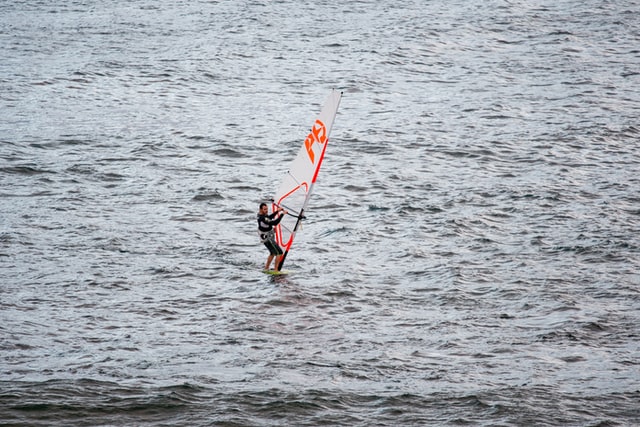Wind surfing is a combination of surfing and sailing where you use the wind to propel yourself around. This exciting water sport is a relatively recent creation, but is extremely popular. If you make your way down to the beach on a sunny day you will likely see a few windsurfers out enjoying the water. Most windsurfers use a board of between 2 and 2.5 metres, connected with the sail or ‘rig’ which can move in all directions.
Windsurfing involves controlling the direction the wind sends you in while balancing on your board. Missteps will often have you toppling off your board and into the drink! Windsurfing started in California during 1948, but rose to prominence and was refined into the sport we know today during the 60s. While more common along the beaches of warmer countries, here in the UK we have a range of lessons for those interested in windsurfing.
Equipment
Almost all but the most advanced lessons will include the use of windsurfing kit that is kept by the school for the use of learners. Windsurfing equipment is expensive, so buying your own when you are still learning doesn’t make sense. Most will not buy their own equipment for windsurfing unless they are using it regularly, or competing. There are a few pieces of essential kit for you to remember when heading out onto the water:
- Board – Your board is an essential part of your windsurfing kit, most often it will be supplied by your instructor and will be maintained by the instructor between lessons. Make sure you always check your board before heading out, as damage could make learning more difficult. There are many different boards used for different windsurfing conditions, with long boards working well for light wind and shorter ones being more preferable for rougher weather.
- Rig – Your sailing rig will be attached to your board to form your full windsurfing kit. There are different types of rig for different levels of difficulty, weather conditions and locations. The rig is generally made up of the boom, sail, mast and mast foot, which are often sold separately. Most beginners will be using the rig that the instructor selects for them to start out.
- Wetsuit – Keeping warm while out on the water is key for you to keep your motor functions and enjoy your windsurfing experience. While exercising we generally feel warm, but having a wetsuit on will help you keep your body heat and help protect you from the sun or wind.
- Protective Equipment – Boots and gloves are often needed in cold temperatures where a wetsuit would not be enough to keep you warm. More crucially, a helmet and a personal floatation device will keep you above water if you lose your board, as well as protecting your head in case of a collision with another windsurfer or hazards such as any debris in the water.
- Sun cream – The sun can be very damaging for the skin if you are out on the water for a long time. While most of you will be protected by your wetsuit, your face won’t be, so finding a good waterproof sun cream is essential. There are many brands to choose from, but I would recommend those specifically for surfers as they hold up well against the water to protect your skin while you are windsurfing.
Find an Instructor
With many holidays and sunny beach days creating opportunities to windsurf, booking some classes at your local beach or reservoir can give you a taste of the sport to see if you are interested in pursuing it. Most beginners will start of by learning about the equipment, how it fits together, how to use it and what the correct stances are for a successful time windsurfing. This sport involves balance and that is difficult on land, let alone on rough water.
Testing your equipment out on land can really help you to learn. Once you have an idea of how to stand, try testing it out on the water, hopefully with a professional instructor who can help you refine your stance and improve your windsurfing. Once you have improved to the point when you have learned to glide without difficulty you can learn a variety of jumps and twists. Ultimately, when it comes to windsurfing, practice makes perfect. If you spend a lot of time out on the water, then naturally you will improve.
Set Goals
In order to improve your windsurfing, it is important to set goals for yourself as you improve, from learning how to balance on the board to learning how to jump. By continually improving your abilities you can see how far you have come from your first taster session. Windsurfing is a wonderful sport to participate in, both for fitness and fun.
Here are a few windsurfing jumps and skills that can be good to set as goals:
- For competitive or experienced windsurfers there are many jumps that can be fun to try and experience yourself, with forward jumps and flips being part of an experienced windsurfer’s repertoire.
- Complete beginners may want to set goals such as learning how to start windsurfing from the water and turning in different directions, as well as simply staying balanced. These are all crucial to learn in order to begin windsurfing at a higher level.
- Learning more about the windsurfing equipment you use while out on the water and what different sails and boards are designed for can be a great goal if you are considering getting personal windsurfing equipment for your own use.
Here at Bewl Water we offer annual memberships for dedicated windsurfers. If you are interested in learning more, please contact us here. We would be delighted to discuss what you need to enjoy windsurfing at Bewl Water.

